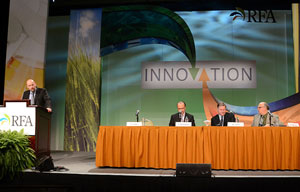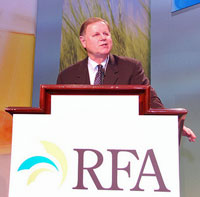 The debate over ethanol, greenhouse gases and land use continues – and that was the topic of a panel discussion at the recent 17th annual National Ethanol Conference.
The debate over ethanol, greenhouse gases and land use continues – and that was the topic of a panel discussion at the recent 17th annual National Ethanol Conference.
The panel, moderated by Renewable Fuels Association VP of Research and Analysis Geoff Cooper, consisted of Thomas Darlington with Air Improvement Resource, Inc.; Dr. David Zilberman with the University of California-Berkeley; and Dr. Wally Tyner with Purdue University. The three experts addressed the latest developments in GHG analysis, and the impact of regulations like the Renewable Fuel Standard and California’s Low Carbon Fuel Standard on the future of the ethanol industry.
 “The new thing is that we now have real world data,” Dr. Tyner said. He presented actual data from the U.S. Department of Agriculture showing that in the last six years the world has added 105 million of crop land – mostly corn, soybeans, rice, rapeseed and wheat. “So, markets work – that’s basically the bottom line,” said Tyner.
“The new thing is that we now have real world data,” Dr. Tyner said. He presented actual data from the U.S. Department of Agriculture showing that in the last six years the world has added 105 million of crop land – mostly corn, soybeans, rice, rapeseed and wheat. “So, markets work – that’s basically the bottom line,” said Tyner.
The question is, how much of that can be attributed to biofuels? “Our estimate is that of that 105 million acres, 5.9 million is due to U.S. soybean and corn ethanol,” he said – or about 5.6%. “So, yes we’ve had a lot of land use change, and some of it’s been due to biofuels, but the lion’s share of it’s due to a lot of other things,” such as growing global population and increased income in countries such as India and China.
Tyner also presented some new estimates of carbon footprint, or land use versus biofuels production capacity for various feedstocks. “Our current estimate for corn is .18 hectares per thousand gallons of ethanol,” said Tyner. “That’s about a fifth of what the original Searchinger estimate was.” A hectare is approximately 2.5 acres.
The really good news Tyner’s research found was that using corn stover for cellulosic biofuels production showed zero land use change. “So in terms of greenhouse gasses, global warming, all of that, it’s golden,” he said, adding that miscanthus also shows great promise with .06 hectares per thousand gallons, but switchgrass did not show up much better than corn at .15.
Tyner is the first to admit that all of this can change and every economic is uncertain, so the debate over land use change could continue “forever.”
Listen to or download an interview with Dr. Tyner here: Dr. Wally Tyner

